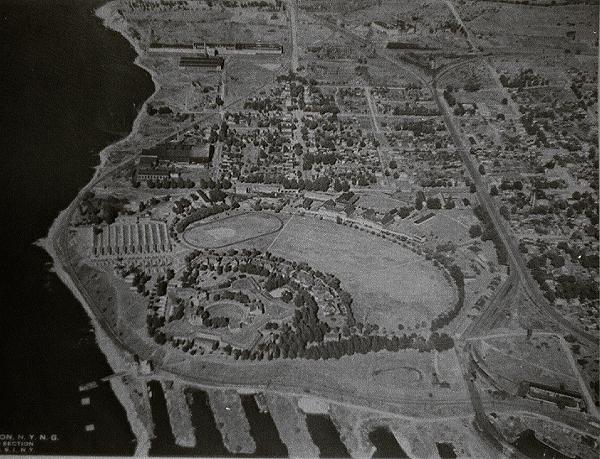 Oswego, New
York
Oswego, New
York Oswego, New
York
Oswego, New
York
New York, Ontario & Western
 On
the east side of the river, the New York, Ontario & Western
Railway came north from Oneida Lake and Fulton and made a great
arc around the northeastern edge of the city to reach a point
on the river near its mouth where the coal and later, transfer
facilities were located. Arriving as the New York & Oswego
Midland in 1868, Oswego was touted as being the great northern
rail terminus for goods from New York City to the west. A large
car and locomotive shop were originally located here but were
closed before 1900.
On
the east side of the river, the New York, Ontario & Western
Railway came north from Oneida Lake and Fulton and made a great
arc around the northeastern edge of the city to reach a point
on the river near its mouth where the coal and later, transfer
facilities were located. Arriving as the New York & Oswego
Midland in 1868, Oswego was touted as being the great northern
rail terminus for goods from New York City to the west. A large
car and locomotive shop were originally located here but were
closed before 1900.
The roundhouse and car repair shop were located on the outside
of the sweeping curve in the northeast corner of the city. Since
non-coal freight traffic was relatively light, no major yard was
constructed. Tracks paralleling the mainline from the roundhouse
area ran along Schuyler Street and almost to the trestles. These
tracks were used for holding coal and any other cars required.
Two main tracks turned south from the trestle leads to reach the
Ames Iron Works, the O&W freighthouse, the O&W station
located at East Bridge and Third Streets and the actual end of
track just beyond. (Station/Shop
Photos). Oddly enough, the track closest to the passenger
station was the New York Central line from Watertown and the next
track over was the O&W main. A crossover was located just
before the unique tunnel carrying the tracks beneath the Oswego
County Courthouse. This allowed O&W passenger engines to run
around the coaches to the roundhouse.
In 1882, the Delaware & Hudson Coal
Company constructed a trestle on the east river front and contracted
with the O&W to service it. The Ontario & Western built
its own trestle across the slip in 1891. The D&H trestle was
gone before 1918 but the O&W trestle transferred millions
of tons of coal to sail and steam-powered colliers until it, too,
was dismantled in 1938. The tracks leading to the docks ran right
along East Schuyler (sky-ler) Street, directly across from the
front yards of dozens of soot-plagued Oswegonians. These trestles
required a switcher to spot cars on and off them. The O&W
trestle had three tracks and the D&H, two, but loading was
accomplished only on the sides facing the slip. (Trestle
photos)
As the coal traffic declined in the 1930's, several programs were
formulated to change the port into a more varied commodities center.
A loader similar to the Lackawanna's was rumored to replace the
trestle. A car ferry service across Lake Ontario to Canada was
researched but deemed impractical. Slowly, with assistance from
state and federal agencies, plus some private funds, a large,
long-term modernization project transformed the east side from
King Coal's domain to a multi-commodity shipping and receiving
point.
With the trestles downed, an extensive reclamation project created
an area for warehouses north of the trestle sites, using not only
the old slip but also the new river frontage. The state of New
York then developed another 1500' of riverfront property south
of the slip for transloading bulk commodities between lake freighters
and canal boats. Metal, quonset-type buildings were constructed
with trackwork and switch throwing mechanisms eventually embedded
in the pavement to accommodate trucks moving through the facility.
Business was brisk in newsprint for New York City papers, iron
ingots, bauxite, lumber, scrap paper and more. Large billboards
proclaimed that the O&W was alive and well. (Downey
Docks)
In 1957, when the Ontario & Western became the first Class
I railroad to be liquidated, the New York Central bought the line
from Fulton to Oswego and as Conrail, continued to utilize much
of the trackage until very recently.
Delaware, Lackawanna & Western